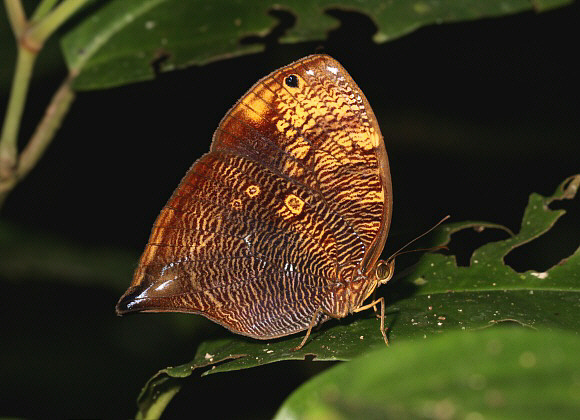 Bia actorion, Satipo, Peru – Adrian Hoskins
Bia actorion, Satipo, Peru – Adrian Hoskins
Introduction
The subfamily Morphinae includes about 140-150 neotropical species, 93 of which are placed in the Brassolini, a subtribe whose genera evolved about 40 million years ago in the late Eocene Period.
Genera included in the Brassolini include Blepolenis, Brassolis, Caligopsis, Catoblepia, Mimoblepia, Opsiphanes, Dynastor, Dasyopthalma, Opoptera, Eryphanis, Selenophanes, Penetes, Orobrassolis, Mielkella and Caligo. All are crepuscular or nocturnal in behaviour, although a few species also fly by day in the darkest areas within their habitats.
| The story of Bia actorion As our knowledge grows and the relationships between different taxa are better understood, it is sometimes necessary for a species to be reclassified under a different genus, tribe, subfamily or family. The most notorious example of this is Bia actorion which was first described by Linnaeus in 1763 as Papilio actorion, and placed in the then all-embracing family Papilionidae. The genus Papilio later became used only for a particular group of Swallowtail butterflies, so in 1819 H�bner created a new genus Bia to accommodate actorion and placed it in the family Satyridae. In the late 20th century taxonomists concluded that the Satyridae, Brassolidae, Amathusiidae, Acraeidae, Heliconiidae etc should be relegated to become subfamilies within the Nymphalidae. For a while Bia actorion ( a.k.a. Napho actoriaena! ) was retained in the Satyrinae, but further studies determined that it really belonged to the Brassolinae. Currently actorion and it’s relative peruana are classified as members of the subtribe Biina and placed in the Brassolini. The Morphini ( Antirrhea, Morpho, Caerois ), Brassolini ( Bia, Narope, Caligo, Opsiphanes etc ), and the Oriental Amathusiini are now regarded as tribes of equal rank within the Morphinae – a subfamily of the Nymphalidae. |
Bia actorion is found in the upper Amazon areas of Brazil, Ecuador, Peru and Bolivia. The only other member of the genus Bia peruana, as its name suggests is restricted to Peru.
Habitats
This species is restricted to undisturbed primary rainforest at altitudes between 0-800 m.
Lifecycle
I have no information regarding the lifecycle of actorion. All other Brassolini species feed as larvae on monocotyledons, using bamboo, plantain, banana, Heliconia or palms according to species and it is reasonable to deduce that Bia has similar habits.
Adult behaviour
The adults are common and widespread. They are usually encountered as singletons disturbed from rest while the observer is walking along narrow forest trails. They are said to feed at decomposing fruit on the forest floor, but all examples I have seen ( several dozen in total ) have been found at rest on foliage in the understorey or seen in flight along dark narrow forest tracks. If disturbed from rest they invariably fly deep into the undergrowth and remain there until long after the perceived threat has passed.
